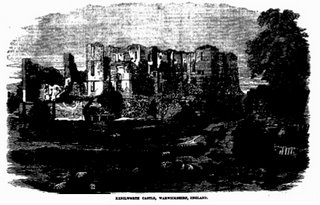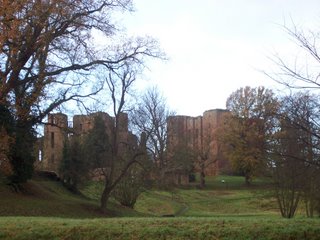 Engraving from Ballou's Pictorial Drawing-Rom Companion, November 5, 1859
Engraving from Ballou's Pictorial Drawing-Rom Companion, November 5, 1859In 1838, a travelling correspondent for the American Episcopal Observer described his first sight of Kenilworth Castle: “We saw immediately before us emerging from the trees the ivy-mantled ruins of this once princely mansion, meet emblem alike of the vanity and power of man, its ruined condition bearing witness of the folly of his efforts to render his name immortal, and its very existence, still defying the assaults of time, speaking of his power... Sic transit! is written in letters of light on every thing the eye rests upon.” Leicester’s gatehouse was occupied as a farmhouse, the medieval barn was still stocked with hay, and sheep grazed in the castle’s courtyard. Ragged little girls from the “straggling village” clustered around the main gate, approaching visitors with guidebooks that sold for a shilling. Melancholy rooks wheeled above the crumbling walls.
Nineteenth-century American visitors to Kenilworth arrived with their heads full of Sir Walter Scott’s descriptions of the pomp of Queen Elizabeth’s visit to the castle in 1575. The contrast with the present ruined state of the castle was impressive, and presented a kind of moral spectacle. “Time has outwatched each warder,” wrote another American visitor in 1847, “and hung its mouldering hatchment over all who have lived and struggled here. As I behold in imagination the stern, severe Elizabeth, passing beneath yonder arch on her gallant steed, and princes and nobles of every degree pressing on her steps, and then turn to the deserted ruin, I involuntarily exclaim, ‘Ghosts are we all!’”
In 1844, an American named C. W. Thomson contributed a poem about the ruins of Kenilworth Castle to the literary magazine The Friend. The poet contrasted the pomp and pride of Queen Elizabeth’s reign with the ruins of the castle, which were a reminder that even the proud and powerful must die, and that “earthly gain” ultimately amounts to nothing:
Riches take wings and fly.
Fame, honour, grandeur, all must fade away—
But the redeemed, in life’s extremity,
Shall find in Christ their stay.
At the end of the nineteenth-century, Kenilworth Castle was so crowded with tourists that it became harder to yield to the melancholy moral romance of the place. An American “bohemian” on a tour of England in 1896 complained: “Scores of holiday-making visitors, who literally swarmed over every nook and cranny in the place, shortened our visit; and I was not able to reconstruct the home of poor ill-fated Amy Robsart out of the few scattered remnants that remain, nor able to dream of the love of Queen Bess for Leicester, with a horde of noisy sightseers rushing about.”



No comments:
Post a Comment